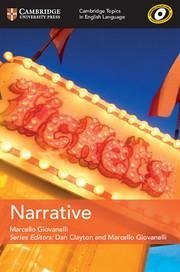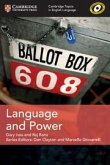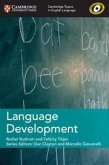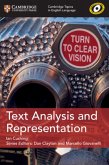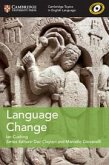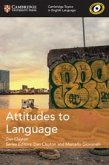- Broschiertes Buch
- Merkliste
- Auf die Merkliste
- Bewerten Bewerten
- Teilen
- Produkt teilen
- Produkterinnerung
- Produkterinnerung
Essential study guides for the future linguist.
Andere Kunden interessierten sich auch für
![Cambridge Topics in English Language Language and Gender Cambridge Topics in English Language Language and Gender]() Felicity TitjenCambridge Topics in English Language Language and Gender30,99 €
Felicity TitjenCambridge Topics in English Language Language and Gender30,99 €![Cambridge Topics in English Language Language and Power Cambridge Topics in English Language Language and Power]() Gary IvesCambridge Topics in English Language Language and Power30,99 €
Gary IvesCambridge Topics in English Language Language and Power30,99 €![Cambridge Topics in English Language Language Development Cambridge Topics in English Language Language Development]() Rachel RudmanCambridge Topics in English Language Language Development29,99 €
Rachel RudmanCambridge Topics in English Language Language Development29,99 €![Cambridge Topics in English Language Text Analysis and Representation Cambridge Topics in English Language Text Analysis and Representation]() Ian CushingCambridge Topics in English Language Text Analysis and Representation30,99 €
Ian CushingCambridge Topics in English Language Text Analysis and Representation30,99 €![Cambridge Topics in English Language Language Change Cambridge Topics in English Language Language Change]() Ian CushingCambridge Topics in English Language Language Change29,99 €
Ian CushingCambridge Topics in English Language Language Change29,99 €![Cambridge Topics in English Language Attitudes to Language Cambridge Topics in English Language Attitudes to Language]() Dan ClaytonCambridge Topics in English Language Attitudes to Language30,99 €
Dan ClaytonCambridge Topics in English Language Attitudes to Language30,99 €![Cambridge Topics in English Language Language Diversity and World Englishes Cambridge Topics in English Language Language Diversity and World Englishes]() Dan ClaytonCambridge Topics in English Language Language Diversity and World Englishes30,99 €
Dan ClaytonCambridge Topics in English Language Language Diversity and World Englishes30,99 €-
-
-
Produktdetails
- Produktdetails
- Cambridge Topics in English Language
- Verlag: Cambridge University Press
- Seitenzahl: 116
- Erscheinungstermin: 25. Januar 2018
- Englisch
- Abmessung: 230mm x 158mm x 6mm
- Gewicht: 166g
- ISBN-13: 9781108402293
- ISBN-10: 1108402291
- Artikelnr.: 48916772
- Herstellerkennzeichnung
- Libri GmbH
- Europaallee 1
- 36244 Bad Hersfeld
- gpsr@libri.de
- Cambridge Topics in English Language
- Verlag: Cambridge University Press
- Seitenzahl: 116
- Erscheinungstermin: 25. Januar 2018
- Englisch
- Abmessung: 230mm x 158mm x 6mm
- Gewicht: 166g
- ISBN-13: 9781108402293
- ISBN-10: 1108402291
- Artikelnr.: 48916772
- Herstellerkennzeichnung
- Libri GmbH
- Europaallee 1
- 36244 Bad Hersfeld
- gpsr@libri.de
1. Defining narrative: 1.1. Some basics
1.2. Representation
1.3. The social aspect of narrative
2. Written narratives: 2.1. Authors and narrators
2.2. Point of view
2.3. Modal grammar
2.4 Multimodal narratives
3. Spoken narratives: 3.1. 'Big' and 'small' stories: narrative and identity
3.2. Co-constructing narratives
3.3. Stories about place
4. Reading narratives: 4.1. Reading narratives
4.2. Deixis and deictic shift theory
4.3. Intertextuality
4.4 Reading characters
5. Narrative genres: 5.1. Narrative and the news
5.2. Children's narratives
5.3. Narrative and Twitter
Ideas and answers
References.
1.2. Representation
1.3. The social aspect of narrative
2. Written narratives: 2.1. Authors and narrators
2.2. Point of view
2.3. Modal grammar
2.4 Multimodal narratives
3. Spoken narratives: 3.1. 'Big' and 'small' stories: narrative and identity
3.2. Co-constructing narratives
3.3. Stories about place
4. Reading narratives: 4.1. Reading narratives
4.2. Deixis and deictic shift theory
4.3. Intertextuality
4.4 Reading characters
5. Narrative genres: 5.1. Narrative and the news
5.2. Children's narratives
5.3. Narrative and Twitter
Ideas and answers
References.
1. Defining narrative: 1.1. Some basics
1.2. Representation
1.3. The social aspect of narrative
2. Written narratives: 2.1. Authors and narrators
2.2. Point of view
2.3. Modal grammar
2.4 Multimodal narratives
3. Spoken narratives: 3.1. 'Big' and 'small' stories: narrative and identity
3.2. Co-constructing narratives
3.3. Stories about place
4. Reading narratives: 4.1. Reading narratives
4.2. Deixis and deictic shift theory
4.3. Intertextuality
4.4 Reading characters
5. Narrative genres: 5.1. Narrative and the news
5.2. Children's narratives
5.3. Narrative and Twitter
Ideas and answers
References.
1.2. Representation
1.3. The social aspect of narrative
2. Written narratives: 2.1. Authors and narrators
2.2. Point of view
2.3. Modal grammar
2.4 Multimodal narratives
3. Spoken narratives: 3.1. 'Big' and 'small' stories: narrative and identity
3.2. Co-constructing narratives
3.3. Stories about place
4. Reading narratives: 4.1. Reading narratives
4.2. Deixis and deictic shift theory
4.3. Intertextuality
4.4 Reading characters
5. Narrative genres: 5.1. Narrative and the news
5.2. Children's narratives
5.3. Narrative and Twitter
Ideas and answers
References.

